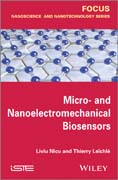
Most books dedicated to the issues of bio–sensing are organized by the well–known scheme of a biosensor. In this book, the authors have deliberately decided to break away from the conventional way of treating biosensing research by uniquely addressing biomolecule immobilization methods on a solid surface, fluidics issues and biosensing–related transduction techniques, rather than focusing simply on the biosensor. The aim is to provide a contemporary snapshot of the biosensing landscape without neglecting the seminal references or products where needed, following the downscaling (from the micro– to the nanoscale) of biosensors and their respective best known applications. To conclude, a brief overview of the most popularized nanodevices applied to biology is given, before comparing biosensor criteria in terms of targeted applications. INDICE: 1. Introduction 1.1. What is biosensing? 1.2. Biosensing applications and examples 1.3. The interest of miniaturization for biosensing 1.4. The components of miniaturized biosensors 2. MEMS transducers 3. MEMS functionalization 4. Associated fluidics 5. From MEMS to NEMS biosensors 6. Conclusions 6.1. Comparing performances of MEMS biosensors? 6.2. Limits and conditions for the success of MEMS/NEMS biosensors 6.3. Technological and application outlooks
- ISBN: 978-1-84821-479-8
- Editorial: ISTE Ltd.
- Encuadernacion: Cartoné
- Páginas: 144
- Fecha Publicación: 03/02/2014
- Nº Volúmenes: 1
- Idioma: Inglés
